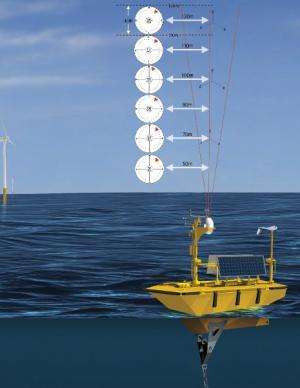Everyone knows it's windy . . .

... And now they have the data to prove it. The middle of Lake Michigan is a vast, untapped reservoir of wind energy. The next step will be to find out if it can be harvested economically without harming the environment.
The data comes from a six-ton buoy that was deployed at three locations in the lake: two points near the Muskegon shoreline and about 35 miles off shore. Loaded with scientific equipment, it has provided the first direct measurement of wind over the Great Lakes at the height of commercial turbines.
The project was led by Grand Valley State University’s Michigan Alternative and Renewable Energy Center and funded primarily by the US Department of Energy and the Michigan Public Service Commission.
To analyze the data streaming from the buoy, the Grand Valley State researchers called upon Guy Meadows, formerly of the University of Michigan and now the director of Great Lakes initiatives for the Great Lakes Research Center at Michigan Technological University.
“We’ve been carrying on that analysis at the Michigan Tech Research Institute,” Meadows said. “It’s very complex.”
Indeed. The buoy shoots three laser beams up into the air that sense wind speed and direction. They take measurements 1,000 times a second at six elevations, from 20 meters to 175 meters above the water. The data are averaged at one-second intervals and stored on the buoy. Then every 10 minutes, it sends a report out via a cell or satellite connection.
The buoy is solar and wind powered and has a backup diesel generator. It can run fully automated for almost a year.
“This is really quite an instrument,” Meadows said, and the results have been “very interesting.”
“In particular, winds measured close to the shoreline were very turbulent, because of the presence of land. But the farther the buoy was from shore, the more the fluctuations were reduced.”
That’s important for wind generation, because the less turbulence, the more efficient the wind turbine and the less stress placed on its support structure. But that doesn’t necessarily mean new wind farms will sprout up tomorrow.
“The Great Lakes in general are very wind rich, second only to the Pacific Northwest,” Meadows said. “The question is, how do you capture that energy in an environmentally conscious way? And from an engineering standpoint, how do design equipment that will capture it and survive our most severe weather? These are big challenges.”
The next phase of this research aims to answer those questions. Michigan Tech and Grand Valley State are seeking funding from the US Department of Energy for the initial engineering and design of floating turbine technology. Energetx Composites LLC, a wind turbine blade manufacturer based in southwestern Michigan, is among the partners in the project.
The idea is to design wind turbines and advanced floating platforms that could be installed miles out in the lake, a location that offers two advantages: it’s so far from shore that it should have little or no environmental impact on the coastal zone, and the wind out there is wonderful for power generation.
“We want to know, ‘Does it make sense to harvest this from all perspectives?’” Meadows said. “Michigan Tech’s role will be as provider of unbiased data.”
Whatever the outcome, the scientific implications go well beyond evaluating the feasibility of commercial wind development.
“The Great Lakes behave just as the oceans do, but with one major difference: we drink the water,” Meadows said. “The buoy gives us a tremendous ability to forecast winds and weather, which means we would be much better at telling cities when they need to shut down water intakes because of pollutants.”
And with better wind measurements also come better wave and current prediction, important for navigating not just Lake Michigan, but all the Great Lakes.
“This has been so successful that Michigan Tech is leading an effort to acquire a second buoy for Lake Superior,” Meadows said. If anything, the results should be even more promising than in Lake Michigan, he added. “Throughout the Great Lakes the wind speed increases as we move farther north.”
Provided by Michigan Technological University



















